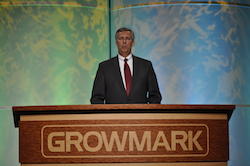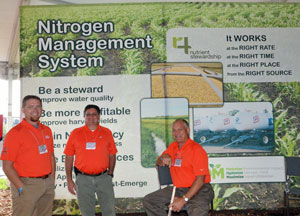 Ethan Luth is product manager for seed treatment products and works specifically on insecticides that are used on corn, soybeans, cotton or cereal crops. During last week’s Farm Progress Show, Bayer CropScience invited us to chat with them about some of their products during a media event held in their giant air-conditioned tent.
Ethan Luth is product manager for seed treatment products and works specifically on insecticides that are used on corn, soybeans, cotton or cereal crops. During last week’s Farm Progress Show, Bayer CropScience invited us to chat with them about some of their products during a media event held in their giant air-conditioned tent.
“Poncho/Votivo is a product that has been around for a couple of years. Growers have come to recognize the Poncho name and trust it for insect control. The benefit of Poncho/Votivo is it brings nematode protection as well. We are working with that in soybeans specially now as growers encounter more issues with nematodes.”
The United States experiences a large variance when it comes to weather. And that has defiantly rang true this summer. Ethan said they put their products through many different environments to figure out where they work the best or where they don’t work at all. He said Poncho/Votivo works very well in many different conditions and referenced the drought we had two years ago.
Ethan also talked about a first of it’s kind product that we can see on the marketplace in early 2015. It will be the first seed treatment that you can apply to soybeans to manage sudden death syndrome. It is a fungicide chemistry that will stop the fungus that causes sudden death syndrome. It will manage against the disease and give growers better yields.
Ethan also discussed with me what Bayer CropScience has in the research and development stages when it comes to seed growth. Listen about that and more in my complete interview with Ethan:[wpaudio url=”http://zimmcomm.biz/farm-progress/fps-14-luth.mp3″ text=”Interview with Ethan Luth, Bayer CropScience”]













